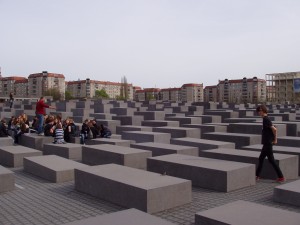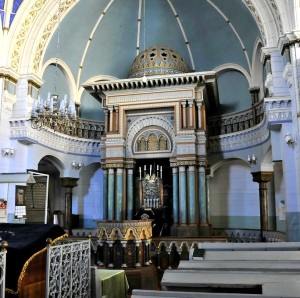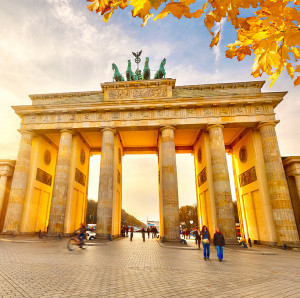
Mission to Vilnius and Berlin

Memorial to the Murdered Jews of Europe in Berlin
Join the Milwaukee Jewish Federation’s mission to Vilnius, Lithuania and Berlin, Germany.
Dates
- Depart Milwaukee on Thursday, October 27
- Tour Vilnius on Friday, October 28 – Monday, October 31
- Travel to Berlin on Monday, October 31
- Return to Milwaukee on Friday, November 4
Cost
- $3,885 based on double occupancy
- $2,585 Land only/Airfare from Vilnius to Berlin included
- $500 Minimum donation to the Milwaukee Jewish Federation 2017 Annual Campaign
Highlights
- Dedication of two mass graves with Father Patrick Desbois of Yahad – In Unum and witnesses of the killings. Learn about the witnesses and hear their stories.
- Visit the Rudnicki Forest with Fania Brancovskaja where she hid during the Holocaust.
- Visit the Ponar Forest where a World War II tunnel that Jewish prisoners dug to escape Nazis was recently discovered.
- Guided tours of Vilnius including the Vilna Gaon Jewish State Museum, the Vilnius Choral Synagogue and the Museum of Genocide Victims.
- Meeting with author Ruta Vanagaite who will discuss her book “Musiskiai” (“Our People”) about visiting killing fields in Lithuania and Belarus. Her book was co-authored with Efraim Zuroff, the renowned Nazi hunter and director of the Simon Wiesenthal Center’s Israel office.
- Meetings with high level governmental officials.
- Guided tours of Berlin including the Brandenburg Gate, the Holocaust Memorial and Exhibit, the Book Burning Memorial, Berlin Wall Memorial, the Reichstag, Topography of Terror, Checkpoint Charlie, Jewish Museum of Berlin, the New Synagogue, Gleis 17, the Weissensee Jewish Cemetery, East Side Gallery of Wall Paintings and the Wansee Conference House where the “Final Solution was engineered.”
- Meeting with representatives of the House of One, a shared house of prayer and learning for Jews, Christians and Muslims.
About Vilnius

Choral Synagogue, Vilnius
Vilnius used to be a very important Jewish Center in Europe. From the 14th century onwards Jews settled in the city, and by the 18th century, Vilnius had become the world center of traditional Talmudic learning, eventually becoming known as the Jerusalem of Lithuania, or more generally the Jerusalem of the North.
The pre-World War II numbers are staggering: Vilnius’ Jewish population was nearly 100,000, about forty-five percent of the city’s total. There were two hundred Jewish communities across the country sustaining the lives and livelihoods of about 240,000 people. Vilnius had 105 synagogues and prayer houses. There were six daily Jewish newspapers. Yiddish was the language of choice.
The post-war numbers are horrifying: Only 24,000 Jews survived, as approximately 90 percent of the Jews had been murdered. Today, Vilnius’ Jewish population is 5,000, a mere five percent of what it once was. The country is home to 6,500 Jews, some 200 of whom are Holocaust survivors. Most of the two hundred pre-war communities were decimated, wiped off the map entirely. There is only one Jewish newspaper. Few people speak Yiddish anymore. Today, only one synagogue remains in Vilnius.
About Berlin

Brandenburg Gate, Berlin
Berlin became the center of Jewish enlightenment as the 18th century drew to a close and came to advocate for Jewish equality and secularism. The Weimer years (1919-1933) were the golden age of the German and Berlin Jewry. By 1933, 160,000 Jews called Berlin home. In the years leading up to the Nazi’s ascendance to power, attacks on Jews increased. Between 1941 and 1943, all the Jews were deported to camps throughout Europe and on June 16, 1943, Berlin was declared “clean of Jews.” By 1945, only 8,000 Jews remained in Berlin and most who survived were in hiding or married to non-Jews.
Germany has confronted its past. Public schools are required to teach about the Holocaust and make mandated visits to former concentration camps. Reparation payments were made to victims, and laws were enacted to make it a crime to deny the Holocaust or to display Nazi symbols. Immigration laws were finally liberalized no longer requiring German blood as a precondition to becoming a citizen.
The Germany of today is a different place, particularly in Berlin, where 45,000 Jewish residents now live. Waves of immigrants have arrived every decade since the war ended. Most recently large numbers of young Israelis are moving to Berlin, attracted by arts, culture, and a more reasonable cost of living. Ironically they live quite peaceably in the same emerging neighborhoods as young Muslim emigres. And for the first time since the war, German-speaking rabbis are being trained in seminaries.
Learn more
To learn more about the mission, email or call Patti Levy at 414-390-5733.
2015 SHOFAR KRAKOW Mission


